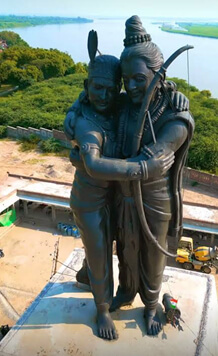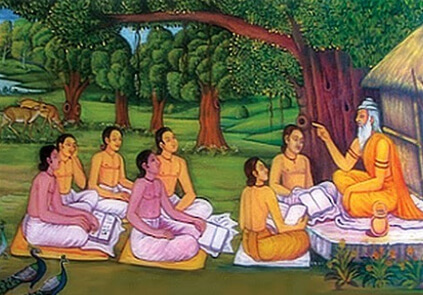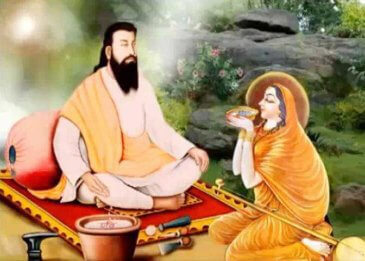
15 December, 2024
Samras Bharat
India, the land ancient culture thriving for thousand years which connects all, is inclusive, in which the feeling of well-being is embedded, which promotes the philosophy of Vasudev Kutumbkam, incorporating the entire world in its ideals. Now this culture is accused of promoting discrimination. This accusation is very serious indeed. In a culture where a Kshatriya prince befriends a person from Nisad tribe, makes him sit with respect in his court, and eats the leftover berries of a Bhil tribe woman, it seems sad that such a situation exists in the land of the ideal man of the nation, Shri Ram. There has been a mistake somewhere for some reason.

Here, there is no evidence of caste-based or gender-based discrimination here either. India is the only culture in the world where women have been given equal or even higher status than men. Ardhanarishwar means that half of God's share is of women, this belief has been there since ancient times, and thoughts like "Yatra Naryastu Pujyante Ramante Tatra Devata" are part of our religious scriptures. We should have faith that we have indeed been the bearers of a great harmonious culture. Even in our Vedas there is no mention of any discrimination on the basis of caste or varna. All these conspiracies actually started during the time of colonial rule. We will also try to know from many references that in India everyone had all the rights, both for education and worship.
Harmonious education system
The ancient education system of India was based on Gurukul. Veda, Vedanga knowledge and weaponry training were given to the students in Gurukul along with the study of scientific research done by the sages. There are many evidences of women's education also mentioned in the scriptures. Lilavati was a great mathematician of ancient India. Evidence of co-education is also found in the scriptures, from Bhavabhuti's 'Malatimadhava' written in the 8th century AD, we come to know that Bhikshuni Kamandaki had received education in a famous education center along with Bhurivasu and Devarata. In 'Uttar-Ram-Charit' also we find that Atreyi was receiving education with Kush and Luv. The historical debate between Gargi and Yajnavalkya is mentioned in the Brihadaranyaka Upanishad, which took place during a debate held in the court of King Janak. This proves that in Jambudweep there was no difference in knowledge between men and women.

Even before independence, when India was a colony of Britain, there are many evidences which show that people of all castes used to get education together. A semi-official survey was conducted by W.Adam in the Bengal Presidency. The survey covered all 21 districts of the Presidency. The survey found that in the Odia district of Ganjam, 808 students were Brahmins, 243 Vaishyas and the highest number of 1001 were Shudra students while students from other castes were 888, these were Avarnas. In Malabar, upper caste students were 20 percent while Shudra category students were 54 percent. In Bellary, upper caste Brahmin and Vaishya students constituted 33 percent while Shudras constituted 63 percent. In Ganjam, upper caste students were about 35.6 percent while Shudra and other caste students were 63.5 percent. Only in the Telugu speaking districts of Visakhapatnam and Cuddapah the number of Shudra students was much less than that of Brahmin and Vaishya students. It was still above 41 percent. Similar surveys were conducted in Bihar and Bengal, journalist William Adam conducting a semi-official survey in the Bengal Presidency, financed by the Governor General himself. His report was published as 'Report on the State of Education in Bengal and Bihar 1836 and 1838'. What Adam recorded was much higher than the Madras figures, in primary schools not only the students but also the teachers were of different castes. Apart from Kayastha, Brahmin, Sadgop castes, there were teachers from 30 different castes. One of Adam's important findings was that every village in Bihar and Bengal has at least one school. Thus, there were approximately 1,00,000 schools in 1,50,748 villages in the region. Similarly, he estimated that there are an average of 100 higher education institutions in every district of Bengal, that is, there are a total of 1800 higher education institutions in the 18 districts of Bengal. It can be understood in this sense that if it would had only 6 scholars, then a total of 10,800 scholars would have been there in all educational institutions. This data was collected by the colonial rulers who had no sympathy or prejudice towards the Indian education system. Thomas Babington Macaulay focused on extensive knowledge of Indian knowledge that the entirety of Indian knowledge does not equal even a single shelf of a good European library. During hundreds of years of slavery, some false things were added to our religious texts by the invaders, which caused many distortions in them. Due to this, a situation of confusion has arisen today. Due to all this, the tendency of caste discrimination, untouchability etc. increased. Due to this, upper class and lower class were born.
* DATA SOURCE
1. Dr. Tribhuvan Singh's book ‘शूद्र कौन थे - अवलोकन और समीक्षा’
2. Shri Dharampal's book 'The Beautiful Tree'
Challenge of harmony - false propaganda
India is a culture that recognizes expression since ancient times. Here girls had complete freedom to choose their groom, many swayambars mentioned in the scriptures and texts are proof of this. Shri Ram was chosen by Sitaji in Swayambar itself. But after the rule of the invaders, evils like child marriage and Sati Pratha became prevalent in India. The reason for this was only the atrocities committed on Indian women by foreign rulers.
Our culture has recognized a person who mend shoes as a saint because of his devotion. Due to his poetic works, he has been given a special place as a great poet. Not only this, a queen of the Kshatriya clan took education from this great man Saint Ravidas, considering him as her guru.

There were no restrictions of any kind for worship here. Due to the heavy Jaziya tax imposed on pilgrimage by foreign rulers, only people with money could go to pilgrimage sites, it was not based on caste. Most of the people belonging to Brahmin, Kshatriya or Vaishya caste were also unable to go to places of worship due to heavy taxes. One of the major changes that took place in India's education system after Macaulay's arrival in India was that India's history was wrongly written and wrongly propagated. For this reason, the evil practice of caste system was born in large areas of India. Due to the divide and rule policy of the British, caste animosity was spread in India. Since then India has been witnessing ethnic conflicts. Such discrimination is a hindrance in the path of India's progress. That is why some institutions, organizations and people are also trying for the harmony of India. Surya Foundation has emerged as a big name among them. Gram Gaurav Mela started by Surya Foundation has established a big milestone in the harmony of India.
Gram Gaurav Mela
Surya Foundation has been doing the work of harmony through seminars and discussions under Adarsh Gaon Yojana for a long time. In the year 2019, Surya Foundation laid the foundation stone of a comprehensive program with the aim of instilling a sense of harmony in the villages. This program, which starts from the first day to the ninth day of Navratri, showed revolutionary changes in the rural areas. The format of this program is such that no children, old people, youth or women remain untouched by it.
Program format - On the first day of Navratri, the women of the village organise Kalash Yatra in the entire village, which is later ceremoniously installed in the temple.
On the second day, speech competition and rangoli competition are organized. In the Rangoli competition, rangoli is made by girls, many of which give the message of environmental protection and goodwill. This increases creativity level in them. People of all ages can participate in the speech competition. In which they have to deliver speeches on topics like nation, society, religion and science etc.
The third day is filled in colors, no no, I am not talking about Holi in Navratri! Rather, a painting competition is held on this day.
The fourth day is celebrated as Devotional Day (Bhakti Diwas). On this day, activities such as morning processions (Prabhat Pheri), devotional singing (Bhajan-Kirtan), Durga recitation (Durga Path), and others were conducted.
On the fifth day, physical ability is showcased, Surya Namaskar competition is organized on this occasion. Many youth perform thousands of Surya Namaskars.
On the sixth day, the focus shifts to entertainment and laughter. On this day chair races and pot races are organised, It is not merely a source of entertainment, but a game that requires concentration, discipline, and agility. Women and girls participate in these with great interest.
On the seventh day there is a home decoration competition, people of the entire village clean their houses. Not only women but also children and men participate with great enthusiasm in home decoration. On the eighth day, a beauty contest is held. On this day, mothers and sisters adorn themselves, and they also decorate the children. The village is filled with little Kanhas, small Rams, and Radhas, all dressed up and roaming around.

The ninth day begins with the Kanya Pujan (worship of young girls) and concludes with the honoring of elders. Elders and others involved in organizing and managing the event are honored during the program. Following this, a fair is organized.
TRANSFORMATION AND IMPACT
The idea of Gram Gaurav Mela program was very successful. People from all castes of the village participated in all the activities of this 10-day program without any discrimination. And it is not that these programs were organized in only a few villages, alone in the year 2024, Gram Gaurav Mela was organised in 341 villages. From planning to organize the event, more enthusiasm was seen among the elders than among the youth. The responsibility of organizing the stage, pavilion, tent, chairs, and the fair was undertaken by the men. In 2024, Gram Gaurav Mela was organized from 3rd October, the first day of Navratri, till Vijay Dashami, 12th October. This event took place in 17 states across the country. 22 villages of Madhya Pradesh, 12 villages of Gujarat, 9 villages of Maharashtra, 17 villages of Hindupur (Andhra Pradesh), 7 villages of Bidar (Karnataka), 12 villages of Rajasthan, 10 villages of Uttarakhand participated in this event. Apart from this, 252 villages from the provinces like Awadh, Bareilly, Gorakhpur, Kanpur, Brij, Kashi, Meerut, Haryana, Delhi, Chhattisgarh, Darjeeling, Assam, Manipur, Jharkhand, Odisha etc. also witnessed the Gram Gaurav Mela. A total of 22350 people participated in these events including women, children and men.
Gram Gaurav Mela has now started becoming a part of the village culture, every year the villagers are eager to organize this program with enthusiasm themselves.
Gram Gaurav Mela has emerged as a successful experiment in bringing harmony back into the culture of India.
